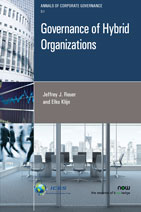Governance of Hybrid Organizations
Jeffrey J. Reuer, University of Colorado, USA, jeffrey.reuer@colorado.edu , Elko Klijn, Old Dominion University, USA, eklijn@odu.eduAbstract
The last few decades have witnessed significant changes in corporate governance practices by organizations that aim to improve the credibility and accountability of corporate boards of directors. In parallel with these developments in practice, academic understanding of the composition, function and value of corporate boards has been enhanced in the fields of law, corporate finance and management. However, it is striking that these theoretical advances have not yet been extended to other types of organizations, such as collaborative agreements, despite their overall economic importance as well as their comparable as well as unique governance needs. In fact, corporate governance theory and alliance governance research have largely developed independently from one another and remain separate literatures. The purpose of this essay, therefore, is to identify and develop some bridges between the two large literatures by considering the similarities and differences between hybrids and traditional corporations as organizational forms and by explicating some of the implications for the governance of collaborative agreements. We begin to trace out some new possibilities for a research agenda that would cross-pollinate the disparate streams of research on corporate governance and alliance governance.
Governance of Hybrid Organizations
Despite considerable advances in the domain of corporate governance research, to date alliance scholars as well as corporate governance scholars have not begun to systematically analyze important governance issues related to the size, structure, dynamics, processes, and implications of joint venture boards and alliance committees. Significant opportunities exist to draw from the expanding corporate governance literature and bring such questions into the research agenda.
Governance of Hybrid Organizations is the first attempt to develop theory and understand boards of directors in joint ventures. In doing so, it is important to draw from corporate governance research in a deeper manner. This monograph focuses on the structural design of boards, its interplay with other governance instruments, and reviews governance solutions in other types of hybrid organizations.
After an in-depth introduction, Section 2 discusses board composition in joint ventures and board involvement and the unique roles that these directors fulfill. Section 3 discusses the topic of board leadership structures in joint ventures and the antecedents and performance implications of CEO duality in light of potential principal-agent as well as principal-principal concerns. Section 4 examines the unique governance mechanisms in joint ventures and how they potentially complement or substitute the functions of boards of directors. While the previous sections are primarily concerned with the governance solutions available for equity joint ventures, in Section 5 the authors review the governance of other types of collaborations, including non-equity alliances and minority equity partnerships. Finally, Section 6 aims to raise a number of unanswered questions that a research agenda on the governance of hybrid organizations might begin to tackle.
